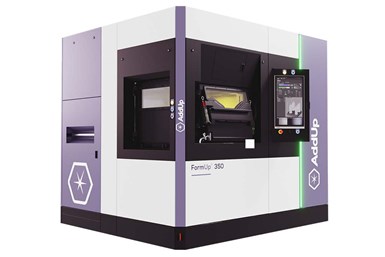AddUp, PostProcess Partner to Scale Metal Additive Manufacturing
Collaboration includes automated metal surface finishing solution with advanced, connected print and postprint pairing.

AddUp’s FormUp 350 New Generation 3D printer is able to produce metal parts not only with medium particle size powder but also with fine powder.
AddUp Group, a metal 3D printing machine manufacturer and producer of parts by metal additive manufacturing (AM), has partnered with PostProcess to advance the metal 3D printing sector and bring streamlined processes to additive users.
Founded in 2016 as the result of a partnership between Michelin and Fives, AddUp offers a catalog of multitechnology production systems and on-demand part manufacturing. The collaboration with PostProcess is designed to bring advanced postprint technology both in-house and to their users with software-driven, scalable surface finishing.
PostProcess and AddUp say they share the vision that AM will not scale sustainably unless the entire process flow from design to finished part is digitized and automated. This is said to require industry collaboration among the ecosystem players. With this partnership, AddUp and PostProcess aim to lay the foundation for scaling affordably and safely the manufacturing of AM parts by not only reducing the cost of postprinting but also improving safety and traceability through digitization and automation.
Joint work has started with an initial focus on parts printed by AddUp for the aerospace, fashion, energy, automotive and medical industries, and postprinted with the PostProcess DECI Duo automated metal surface finishing solution. To drive efficiencies in their own manufacturing endeavors and best support their customers locally, AddUp will also implement the DECI Duo solution in two of its facilities in France and the U.S.
“Digital integration in the postprocessing of additive manufacturing is the point we were looking for to improve the value chain,” says Medhi Offroy, Postprocessing Methods Engineer at AddUp. “The DECI Duo solution is really interesting to reduce surface roughness on delicate metal 3D printed parts. Now we can reach inaccessible surfaces in a quick execution time.”
AddUp’s FormUp 350 New Generation 3D printer is able to produce metal parts not only with medium particle size powder but also with fine powder, which improves the final result of surface roughness reduction, the company says.
Related Content
-
Possibilities From Electroplating 3D Printed Plastic Parts
Adding layers of nickel or copper to 3D printed polymer can impart desired properties such as electrical conductivity, EMI shielding, abrasion resistance and improved strength — approaching and even exceeding 3D printed metal, according to RePliForm.
-
How Electroplating Works for Polymer 3D Printed Parts
Baltimore-based RePliForm specializes in electroplating of 3D printed polymer parts for functional applications. This video explores how the process works, and potential benefits and uses for this technique.
-
Seurat: Speed Is How AM Competes Against Machining, Casting, Forging
“We don’t ask for DFAM first,” says CEO. A new Boston-area additive manufacturing factory will deliver high-volume metal part production at unit costs beating conventional processes.













